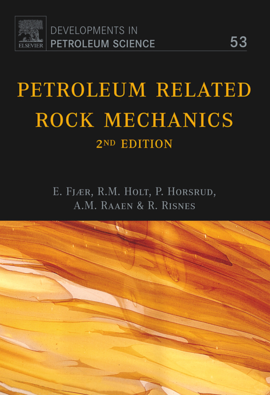井壁稳定模型研究现状
本文摘要:(由ai生成)
钻井中井壁稳定性是油气开采的关键。研究方法包括基于地质力学参数预测安全钻井液密度窗口和室内试验获取地质力学参数。井周应力分析经历了从线弹性到多场耦合分析的发展,考虑了多种因素对井壁稳定性的影响。国内外学者提出了多种模型和计算方法。川西二叠系火山岩油气资源开发中,井壁坍塌失稳机理需进一步研究。这些研究为油气开采提供了科学理论支撑。
国内外钻井工作者已对钻井中井壁稳定性开展了大量研究,主要研究方法可分为两大类,一类是建立连续地层剖面的地质力学参数如地应力、弹性模量、泊松比、内聚力、内摩擦角等与GR、密度、孔隙度、渗透率、电阻率、声波时差等测井资料的经验关系,将预测得到的地层地质力学参数代入井壁稳定的经验关系模型或理论模型,可得到目标区块连续地层剖面的维持井壁稳定的安全钻井液密度窗口,并用于指导井身结构设计[37]-[52];一类是钻取关键层位井下岩心,开展室内试验,测得地质力学参数,并代入井壁稳定理论模型,求解安全钻井液密度窗口[53]-[66]。本研究主要采用第二类方法开展川西二叠系火山岩井壁稳定性研究,并调研了井壁稳定模型的研究现状。

为评估井眼钻开后井周应力集中状态,Westergaard[67]最早给出了一种弹塑性井周应力分布模型,但需要参数较多且难以获取;因此,需求参数较少且测试方便的线弹性井周应力模型被广泛采用,Kirsch[68]最早给出了线弹性井周应力模型,但仅在井眼指向主地应力方向时适用,Fairhust[69]首次得到了任意井眼的线弹性井周应力模型。由于全球范围内,钻遇的页岩地层垮塌严重,针对页岩这种岩性的各向异性特点,Lekhnitskij[70]最早将页岩地层视为横观各向同性材料,建立了横观各向同性介质井周应力模型。国内外众多学者采用线弹性均质介质井周应力模型及针对页岩的横观各向同性介质井周应力模型,分析了地应力异性、井眼轨迹、钻井液密度、地层裂缝面强度、裂缝产状等因素对井壁稳定性的影响,如张明明等[54]研究认为不同地应力状态下,最佳井眼轨迹均位于最大和最小地应力平面内,且平行或偏向于最大地应力方向,原地应力分布状况和井眼的实际空间状态也在很大程度上决定了井眼的稳定性;Dusseault[71]的研究发现裂缝发育页岩中井眼稳定与井眼尺寸、井眼轴向和裂缝面的夹角有关,垂直裂缝面方向钻进有利于井眼稳定;国内Chen[72]、丁乙[73]等基于横观各向同性井周应力解,并采用Jaeger弱面准则,建立了考虑地层发育一组或多组裂缝的井壁失稳模型,分析了裂缝面强度、产状等因素对井壁坍塌压力的影响。Økland[74]、Bautmans[75]等都开展了页岩气水平井失稳状况的室内模拟试验,在发育一组定向裂缝的页岩地层钻进时,失稳区域分布在井筒上下两端,且井周围岩主要沿裂缝面发生崩落,可通过控制井眼轴向与裂缝面夹角减弱井壁的失稳程度;Fan等[76]基于各向同性井周应力模型及Jaeger弱面准则,建立了井周失稳区域预测模型,从理论上解释了上述实验现象,研究证明了发育一组定向裂缝的地层钻开后,井眼呈“四边形”,与常规储层不同,井壁最大崩落位置并不出现在最小水平地应力方向。
应力是影响井壁失稳的主要因素,但仅考虑应力作用,并未很好的解决油气开采中井壁失稳问题,实际钻井工程中,岩石的失效是多场耦合作用的共同结果,如钻井液与地层岩石接触后,会产生热传递及化学反应,温度的升高或降低同样影响化学速率的快慢,反之亦然[77]-[79];岩石属于多孔介质,且真实地下岩石不但充满了流体,且孔隙流体具有压力,地层钻开后,流体在钻井液与孔隙流体压差作用下发生渗透,引起孔隙压力的重新分布,且随时间和距井壁的距离发生变化,在井壁稳定分析中,温度、渗流、化学及其相互之间的耦合作用的影响,同样不可忽视[80]-[83]。实验表明,孔隙压力的变化会引起有效应力的变化,明显的改变裂隙张开度、流速和液体压力在裂隙中的分布,裂隙渗透率会随着正应力增加快速降低。Noorishad等[84]用有限元方法研究了非连续介质中固液两相介质的耦合问题,用节理单元处理几个主要不连续面是一种有效手段,但用于解决所有不连续面是不实际的,小的节理不能单独地在渗透中起重要作用,但连通后会成为渗流主要通道,如不考虑这一因素会导致渗流分析的错误结果;Oda[34]用一个等效模型解决固体和液体两相介质的耦合分析,该模型裂隙与大尺寸的岩体比是足够小的,且能够考虑正应力强度和剪切强度的影响,由裂隙几何张量来建立耦合关系,能较好地反映裂隙岩体应力场与渗流场的相互作用。
我们不仅要研究应力-渗流的耦合问题,还要进一步研究应力-渗流-温度三者的相互作用问题,这方面的研究尚较为少见,Chenevert[85]首次定量研究了钻井液的水化性能对泥页岩性质的影响,结合水化实验数据,运用钻井液与地层流体的活度建立水化应力的表达式;Van Oort[86]认为钻井液与地层岩石相互作用下流体的驱动力包括液柱压力、化学势、电势和温度;Chen[87]等指出在钻井初期,温度是控制孔隙压力的主要因素,温度在页岩中的扩散要比水力和化学物质扩散更快,井壁失稳最先发生在地层内部而不是井壁上,作者还建立了温度与孔隙压力耦合控制方程,认为只考虑热传导效应的低渗透地层和同时考虑热传导与热对流效应的高渗透地层在一定的假设条件下,均能运用Laplace变换得到其解析解;Ghassemi[88]等的研究认为温度和渗透对地层中孔隙压力的影响很大,除了通过增加钻井液的密度,改变钻井液的水活度也是一种有效控制井眼稳定的方法,当地层流体水活度较高时,水分子向井筒内流动,有利于增强井壁的稳定性;Yu[89]等提出了与时间有关的化学-温度-多孔弹性模型来研究化学和温度对井眼稳定性能的影响,该模型考虑了热应力以及由于水和溶质流进或流出地层而造成的温度和孔隙压力的变化,指出由于化学和温度的影响,钻井液的密度随时间而变化,最初能安全的钻井液密度不能保证长时间后仍然安全;Ekbote[90]对运用Laplace变换得到了各向同性及横观各向同性岩石介质的力化热耦合条件下,井周孔隙压力和应力解析解;Abdideh[91]等根据叠加原理,将钻井液温度和化学相互作用对井筒不稳定性的影响耦合在一起,分别用3个判据同时计算出泥浆窗口的上下限,结果表明,钻井液的温度和化学效应缩小了泥浆重量窗口。国内孟英峰[92]、刘向君[93]、邓金根[94]-[96]、卢运虎[97]-[98]、何世明[99]、马天寿[100]-[101]、曹文科[102]-[103]、高佳佳[104]、周俊[105]-[106]等都对易水化地层的井壁稳定问题开展过大量的研究工作,针对井眼失稳问题得到了缓解,形成了大量关于应力场或多场耦合的井眼稳定科研成果。
综上所述,井周应力理论分析大体经历了线弹性到多孔弹性再到塑性分析,单场分析到多场耦合分析的历程,如多孔介质弹性、流固耦合、流固热耦合、力化热流耦合、应变软化等理论,计算手段也从解析、半解析发展到有限差分、有限元、边界元和离散元等数值求解方法,以分析更加复杂的钻探环境[107]-[116]。地层被钻开后,井周围岩的破坏失稳受多种因素的综合影响,目前川西二叠系火山岩油气资源的开发仍处于起步阶段,其井壁坍塌失稳的机理尚不明确、分析方法也不成熟,有必要针对以上现象开展深入的研究,为制定井眼稳定措施提供科学理论的支撑。
参考文献
[1] Sharma R. Strength prediction of weakly cemented sands fromgeophysical logs[D]. Ph. D. dissertation, University of Rhode Island, 2010.
[2] Ma Z. Uncertainty analysis in well log and petrophysicalinterpretations[M]. 2011.
[3] Abbas A K, Flori R E, Alsaba M. Estimating rock mechanicalproperties of the Zubair shale formation using a sonic wireline log and coreanalysis[J]. Journal of Natural Gas Science and Engineering, 2018, 53: 359-369.
[4] Abbas A K, Flori R E, Alsaba M, et al. Integrated approachusing core analysis and wireline measurement to estimate rock mechanicalproperties of the Zubair Reservoir, Southern Iraq[J]. Journal of PetroleumScience and Engineering, 2018, 166: 406-419.
[5] Abbas A K, Flori R E, Ahmed A L A, et al. Laboratory analysisto assess shale stability for the Zubair Formation, Southern Iraq[J]. Journalof Natural Gas Science and Engineering, 2018, 56: 315-323.
[6] Abbas A K, Flori R E, Alsaba M. Stability analysis of highlydeviated boreholes to minimize drilling risks and nonproductive time[J].Journal of Energy Resources Technology, 2019, 141(8): 1-18.
[7] 侯连浪. DQ 区块煤岩力学参数测井预测研究及应用[D]. 西南石油大学, 2018.
[8] Vasquez G, Morschbacher M, Ruthner M, et al. Petrogeophysicsof the Brazilian pre-salt rocks[C]//SEG International Exposition and AnnualMeeting. OnePetro, 2019.
[9] 熊健, 黄林林, 刘向君, 等. 高温影响下页岩岩石的声学特性实验研究[J]. 2019, 41(6),35-43.
[10] Liu X, Ding Y, Ranjith P G, et al. Hydration index andhydrated constitutive model of clay shale using acoustic frequency spectrum[J].Energy Science & Engineering, 2019, 7(5): 1748-1766.
[11] Miah M I. Predictive models and feature ranking in reservoirgeomechanics: A critical review and research guidelines[J]. Journal of NaturalGas Science and Engineering, 2020, 82: 103493.
[12] Liu H, Cui S, Meng Y, et al. A new method for wellborestability evaluation based on fractured carbonate reservoir rock breakingdegree[J]. Arabian Journal of Geosciences, 2021, 14(7): 1-17.
[13] Abraham S, Oniku A S, Meludu O C, et al. Geomechanicalcharacterization of mechanical properties and in-situ stresses for predictingwellbore stability of ATG-field, A case study: Niger delta petroleum province,Nigeria[J]. International Journal of Advanced Geosciences, 2020, 8(2): 126-136.
[14] Bagdeli M, Manshad A K, Shadizadeh S R, et al. Naturalfracture characterization and wellbore stability analysis of a highly fracturedsouthwestern Iranian oilfield[J]. International Journal of Rock Mechanics andMining Sciences, 2019, 123: 104101.
[15] 杨虎, 薛晓军, 陈向辉, 等. 基于测井数据反演火成岩力学参数模型的建立及其工程应用[J]. 天然气工业, 2021, 41(5),101-109.
[16] Akong B, Orimoloye S, Otutu F, et al. Managing WellboreStability Window and Well Integrity by Adjusting the Tight Margin toSuccessfully Drill through Naturally Fractured Zone Onshore Niger Delta[C]//SPENigeria Annual International Conference and Exhibition. OnePetro, 2021.
[17] 张明明, 梁利喜, 刘向君. 页岩储层各向异性对水平井坍塌压力的影响[J]. 应用数学和力学, 2017, 38(3):295-309.
[18] 张明明, 梁利喜, 刘向君. 不同岩石剪切破坏判据对井壁坍塌压力的影响分析[J]. 岩石力学与工程学报, 2017, 36(A01):3485-3491.
[19] 庄大琳. 页岩气藏地层钻井卸载破坏及对井眼稳定性的影响研究[D]. 西南石油大学, 2015.
[20] Zhang, Jincai. Borehole stability analysis accounting foranisotropies in drilling to weak bedding planes[J]. International Journal ofRock Mechanics & Mining Sciences, 2013, 60:160-170.
[21] Aadnoy B S, Looyeh R. Petroleum rock mechanics: drillingoperations and well design[M]. Gulf Professional Publishing, 2019.
[22] Aadnoy B S. Modeling of the Stability of Highly InclinedBoreholes in Anisotropic Rock Formations (includes associated papers 19213 and19886)[J]. SPE drilling engineering, 1988, 3(03): 259-268.
[23] Aadnoy B S. Stresses around horizontal boreholes drilled insedimentary rocks[J]. Journal of Petroleum Science and Engineering, 1989, 2(4):349-360.
[24] Chen X, Tan C P, Haberfield C M. A comprehensive, practicalapproach for wellbore instability management[J]. SPE drilling & completion,2002, 17(04): 224-236.
[25] Zhang W, Gao J, Lan K, et al. Analysis of borehole collapseand fracture initiation positions and drilling trajectory optimization[J].Journal of Petroleum Science and Engineering, 2015, 129: 29-39.
[26] Li Y, Weijermars R. Wellbore stability analysis in transverseisotropic shales with anisotropic failure criteria[J]. Journal of PetroleumScience and Engineering, 2019, 176: 982-993.
[27] Sesetty V, Ghassemi A. Effect of rock anisotropy on wellborestresses and hydraulic fracture propagation[J]. International Journal of RockMechanics and Mining Sciences, 2018, 112: 369-384.
[28] Ding Y, Liu X, Luo P. The analytical model of hydraulicfracture initiation for perforated borehole in fractured formation[J]. Journalof Petroleum Science and Engineering, 2018, 162: 502-512.





